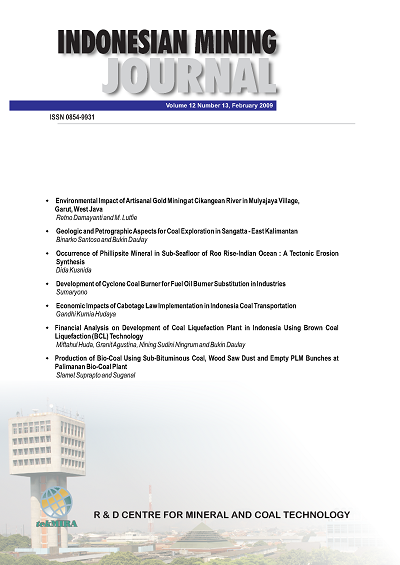Indexed by:
Archives - Page 3
-

INDONESIAN MINING JOURNAL Vol. 11 No. 3 October 2008
Vol. 11 No. 3 (2008)Mining issues in this current journal include the technological and economical aspects of coal and mineral. The Indonesian coals well distributed in Sumatera and Kalimantan, are mostly dominated by low-rank coals such as lignite and subbituminous that have huge resources and reserves. In order to upgrade these coals, their characteristics must be recognised prior to development. The coals are dominantly used as direct fuel at coal power station, particularly close to the mining. Besides being used as the direct fuel, the coal is also upgraded to increase the calorific value. Therefore, it can optimally and safely be utilised as clean coal. Analysis of the economic aspect is also carried out to encourage the utilisation of the coal. This aspect is important to promote devel- opment of the coal to assure the investors of coal mining who wish to invest in the coal mining sector in Indonesia. Industrial minerals, like coal, are also well distributed in Indonesia. The use of them is not optimally yet, particularly for ceramic products. Unfortunately, most of the minerals do not fulfil the requirement of specification. This is challenges for researchers to upgrade to fulfil the specification, so that they can be used directly by related industries.
Study on organic petrology of coal is very important to indicate its type and rank. Geological setting influences those characteristics in terms of the sedimentological aspect. They were deposited in fluvial to deltaic environments. Megascopically, the coals are dominated by bright-banded and banded lithotypes. Microscopically, vitrinite and liptinite are the dominant macerals in the coals. There is significant relationship between those observations. The ranks of the coals range from brown coal to high volatile bituminous. Most of the coals are suitable for feed stocks in combus- tion. Suralaya Coal Power Station is the largest coal power plant in Indonesia. Recently, it uses low rank coal (LRC) because the price of medium and high rank coals is too costly. This is in accor- dance with the government in encouraging using LRC as the main source of energy in the national energy mixed policy. With the advanced technology such upgraded brown coal process; LRC can be used optimally, especially for the power plant. The increase of oil price forces industries to alter fuel from oil into a cheaper one. Coal is a promising energy alternative in Indonesia. Saving the cost, altering the fuel of oil into coal in industries may be accomplished by altering the oil burner with coal burner. The coal combustor should have nearly the same characteristic as the oil one, so that the performance of the kiln or other equipments served by the combustor does change signifi- cantly. Industrial minerals like kaolin, ball clay, quartz and zircon can be utilised as ceramic raw materials. The other ones like bauxite and ilmenite have not been utilised yet for ceramic commodi- ties. So, to empower all industrial types as ceramic raw materials, it is necessary to conduct a comprehensive study on those minerals. It is expected that they can optimally be utilised for white or coloured ceramic bodies, glaze, refractory and other ceramic products. The loading of gold and copper from a pregnant gold-thiosulphate leach solution onto ion exchange resin and the subse- quent elution of these metals have been investigate. The result indicates that gold can be removed from thiosulphate solutions rapidly and loaded on resins to very high concentrations.
The progress and development of the improving technology carried out by the researchers is highly expected to improve the collaboration between R&D institutions and industries, particularly in self fulfilling the commodities in which some of them are imported from overseas, especially from China, Japan and India. Thus, this can reduce dependence of the commodities.
The Editor
-

INDONESIAN MINING JOURNAL Vol. 11 No. 2 June 2008
Vol. 11 No. 2 (2008)Spectacularly infrastructural development in the world, particularly in China and India, makes prices of mineral and coal commodities sharply increase, and this causes high demand of those commodities. It is predicted that it will happen a trend of struggling those resources in the future. However, this case can positively be supposed as the emerging of huge market opportunity. The conflict, even war, takes place in the 20th century and probably will continue in the 21st century in Africa, South America and Asia. This conflict is mostly triggered by the fighting of the mineral and coal resources that are limited in the reserves. For these reasons, Indonesia should play the role of utilising its mineral and coal resources, particularly for the prosperity of the people.
The progress on coal and mineral technology in Indonesia indicates promising results that have been carried out by a lot of researchers from R&D institutions in collaboration with user industries. When the results are developed, it is expected that those commodities can respond and fulfil the needs either domestically or internationally. Indonesia has great iron mineral resources in the forms of primary iron ore, iron sand and lateritic iron ore. There is an opportunity to process it by apply- ing an appropriate technology to obtain the improvement of the result. This is a promising solution to beneficiate the resources for a lot of industries in the country. An effort to reduce iron content in kaolin can be made by applying beneficiation test. The kaolin may become whiter and can reach the standard quality for paper industry. The result of the experiment shows that the optimum con- dition with a certain flow rate gives the quality of kaolin concentrate with a little iron content. An appraisal of the marine magnetic anomalies over the Belitung waters provides information on the distribution of magnetic susceptibility values. The susceptibility distribution analyses reveal a strong correlation between magnetic susceptibility and type of granites. The nature of submerged Belitung intrusive is suggested as granitic pluton that is associated with cassiterite minerals. This strongly indicates that exploration of tin minerals can be carried out in offshore of Belitung island in order to add its reserve. Indonesian coal has a potential to be a major future energy source due to its huge resource, low cost of exploitation, good quality and supported by appropriate infrastructure. Unfortunately, more than 65% of the resources are categorised as low rank coal. This type needs to be upgraded prior to utilising and transporting for a long distance. One of the upgrading pro- cesses is UBC (upgraded brown coal). Therefore, the coal can be used optimally. Geological set- ting of the West Java region has a main role to characterise the coal deposits, especially due to the depositional environment and stratigraphic aspect. According to the petrographic characteristics, the coals are suitable for fuel of direct combustion for the small-scale industries that are present in the surrounding areas. The coals are expected to be able economically to cope with the demand of those industries.
The progress and development of the improving technology conducted by the researchers is ex- pected to improve the collaboration between R&D and industries, particularly in self fulfilling the commodities in which some of them are imported from overseas, especially from China. Thus, this can reduce dependence of the commodities.
The Editor
-

INDONESIAN MINING JOURNAL Vol. 11 No. 1 February 2008
Vol. 11 No. 1 (2008)Exploration and exploitation of mineral and coal in Indonesia have led to concept of the good mining practices. Moreover, the environmental management due to the mining operation of those commodities has already conducted well. The endeavours of researchers and other functional officials that collaborate with mining industries in the rural areas have to orientate to environmen- tally friendly areas. It clearly seems that the mining industry in this country has left the old paradigm to the environmentally friendly mining. This is expected to be able to provide positive impact for the investment climate and the stimulation of the sector of energy and mineral resources that is one of the main contributions of the national budget and expenditure.
Various ideas in the papers provided in this journal try to provide the solution issues on mineral and coal mining, particularly related to technological and environmental aspects that lead to the improvement of value added of those commodities.
Type and rank variation of the Sumateran coals were assessed by petrographic examination. Simi- larities in the type and rank characteristics in the coals reflect their geological setting, climatic influence and peat conditions. Reverse flotation was adopted for Indonesian iron-rich laterite ore from Pomalaa to float siliceous minerals in the separation of iron mineral. It is possible to use the iron-rich lateritic ore to produce magnetic concentrates by using magnetizing roasting followed by reverse iron flotation. The preparation of upgraded brown coal water mixture by using an Indone- sian upgraded coal in a pilot scale was carried out the effect of dispersing and stabilizing additives on the rheological behaviour. The results indicate that the addition of the additives is effective and stable in preparing the upgraded coal. The physical activation of zeolite was conducted by heating the samples, whilst the chemical activation was carried out y using a reagent. It shows the optimal result with certain characteristics. Gold processing at Pongkor mine processes cyanide-containing waste. Due to the increase of environmental awareness from the surrounding community, this process needs to be re-evaluated. This relates to tight regulation regarding safe waste prior to re- leasing to the environment.
The presentation of those papers indicates the various progresses developed in the sector of energy and mineral resources. This is expected to be able to give the positive inputs towards the improve- ment of the utilisation of mineral commodities by applying the environmentally friendly mining. In addition, the papers can trigger researchers and other functional officials to keep endeavouring in solving various issues in this sector.
The Editor
-
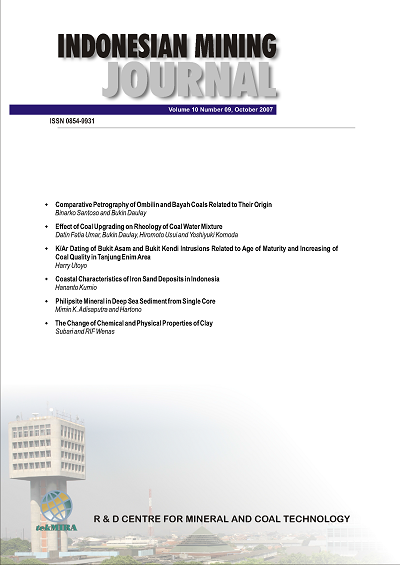
INDONESIAN MINING JOURNAL Vol. 10 No. 3 October 2007
Vol. 10 No. 3 (2007)The main topic of this October 2007 issue relates to coal and mineral technology. For the coal issue, the dependence upon the only energy source like oil fuel must be reduced by utilising an alternative energy that is coal. Moreover, the reserve of the Indonesian oil fuel is decreasing day by day, and this condition is worsened by no new oil resources discovered. Probably, it cannot be avoided that Indonesia will be net importer of oil fuel in the future. For this reason, the Indonesian coal having huge resources mainly located in Sumatera and Kalimantan must be developed to replace the role of oil fuel as a new energy source. Several attempts have been carried out to improve quality of the coal in cooperation with overseas R&D institution from Japan. For the mineral issue, in the current years industrial minerals indicate the recovery of their buried condi- tion. This is shown by the demand increase of various industrial minerals, and thus the mining operation of these commodities reveals its increase, either for fulfilment of the domestic demand or for the export purpose. The improvement of value added of them needs to be focused so that they can optimally be used.
The papers are arranged into the coal and mineral issues. The coal issues are as follows: Two coalfields have petrographically been compared between Ombilin and Bayah. The type of both coals illustrates some similarities. The ranks of the coals are commonly considered to be controlled by the level of temperature of the intrusive rocks; Coal water mixture (CWM) is required to have the highest possible coal concentration and a moderate viscosity to make handling easily; The most influential intrusion to the development of the coal maturity is the Bukit Asam intrusive, while Bukit Serilo shows negative result, presumably is very young and thus, the age could not be de- tected by K/Ar method; The mineral issues are the followings: Geology and geomorphology of the hinterland and the bordering adjacent marine environments control the diversity of coastal fea- tures. The coastal characteristics of iron sand deposits in Indonesia are always associated with volcanic rocks; The phillipsite mineral as one of the members of Natural Zeolite Group was firstly discovered in the Indian Ocean during the MD III-IM-AGES IV Expedition at the depth of 3,884 m below sea level; Treatment on clay as ceramic raw material by draining and firing process at high temperature will denature both physical and chemical properties like the properties of dwindling, mechanical strength and growth of quartz to become new mineral of tridymite.
The problems of the development of the mineral and coal technology as above mentioned are often faced to various issues that need to be coped with rapid and accurate solutions. For this reason, all related researchers from R&D should cooperate hand in hand with industries. This is a marvellous moment to bridge the relationship between them.
The Editor
-

INDONESIAN MINING JOURNAL Vol. 10 No. 2 June 2007
Vol. 10 No. 2 (2007)Papers referring to coal issues particularly low-rank coal are still dominant in this June 2007 issue, especially for the technical aspect. The authors of the papers are aware that most of the Indonesian coals are of low rank. Various attempts have been carried out to upgrade and utilise optimally these coals in order to substitute the role of oil fuel that its reserve is decreasing year by year. These are conducted to support the government policy on energy in which the coals must substitute the oil energy. The other papers focus on technical aspects of mining environment and geophysical inves- tigation.
Petrographic analysis on the Lebak coals indicates that higher vitrinite reflectance of Palaeogene coals, compared to Neogene ones, is a result of higher regional coalification level in the basin, associated with greater cover and local effect of igneous intrusion. The Palaeogene coals have better quality than the Neogene ones. All the coals rich in vitrinite are suitable for direct combus- tion.
Low-rank coals from Adaro (subbituminous); Mulia and Gunung Bayan (lignite) were analysed to produce synthesis gas using fluidised bed gasification reactor. The composition of gas products were analysed using a gas chromatograph. The results show there is a good correlation between gasifying agent, coal used, quality and quantity of the synthesis gas.
Low-rank coal can be upgraded to higher-rank one, both for export and domestic use, mainly for domestic industries. Upgraded Brown Coal (UBC) process is one of the best upgrading processes that can be applied. Moreover, the low cost production of the coal would be the more attractive for its commercialisation.
Study on monitoring system application to detect soil/rock movement at mine slope was carried out in the Binungan Mine Operation-PT. Berau Coal. The system used equipments consisting of radio modem, data logger and potential transducer. The results indicate a good value of linearity with value of r-square of 0.964-0.981.
Prevention and control of acid drainage is a major issue for mine operators at sites where sulphide minerals occur. Overburden treatment technology must be identified and implemented to minimise the production of acid mine drainage.
Existence of water-bearing permeable rock surrounding gold mine in the Tasikmalaya Regency was detected using a Schlumberger configuration. The results show the rocks that is previously not yet known consisting of sandy tuff and breccias tuff.
From all the papers, it could be seen that the issues in coal and mineral development are often faced to various issues that need accurate and rapid solution. These papers have resulted in inputs of the issues on the mining development nowadays.
-
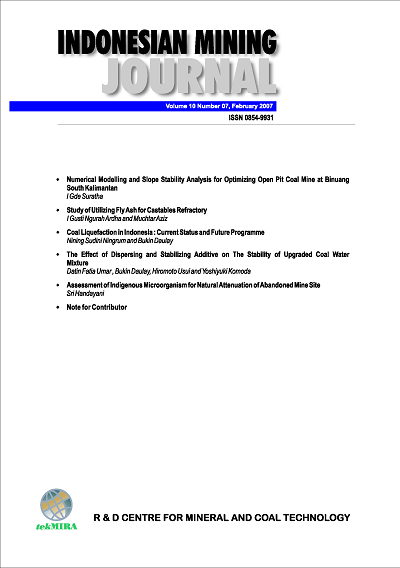
INDONESIAN MINING JOURNAL Vol. 10 No. 1 February 2007
Vol. 10 No. 1 (2007)The main focus of the February 2007 issue is on the technical aspects of engineering mineral and coal technology. If these aspects are to be realised, all problems of the mineral and coal technology can easily be handled by related industries. This reflects that the sector of mineral and coal in this country has a promising future in facing the globalisation era, particularly for the next generation. Numerical modelling study and slope stability analysis determine the optimum pit slope design. This study has successfully been applied to optimise the open pit coal mine at Binuang-South Kalimantan.
Fly ash could be utilised as alumina and silica source material. It could be treated by processes of demagnetisation, sinterisation, grinding, mixing with crushed bricks and fired cement to create acid based on castable refractory.
Over 60% of Indonesia’s coal resources is classified as low rank coal (lignite and subbituminous). Most of the coals occur close to the surface to make it easy and cheap to exploit. The coals may lead to consider technology transforming coal into clean fuels. Coal liquefaction is a suite of tech- nology that can convert the low rank coal into clean liquid fuel, which can be used for transporta- tion.
Stability of upgraded brown coal water mixture was studied based on coal sedimentation time history. The result indicates that the mixture produced by the addition of dispersing additive of NSF
0.3 wt% with stabilising additive of S-194 or CMC 0.01 wt% has a good fluidity with the apparent viscosity.
The indigenous microbial population was found to be present at high level. This indicates that the site matrix did not appear to be inhibitory and relatively favourable to microbial growth. Accor- dingly, it can be suggested that natural attenuation of metal bioremoval would occur under present site condition.
It is expected that all topics could attract researchers to develop all the technological aspects in creating products that can be useful for mankind.
The Editor
-
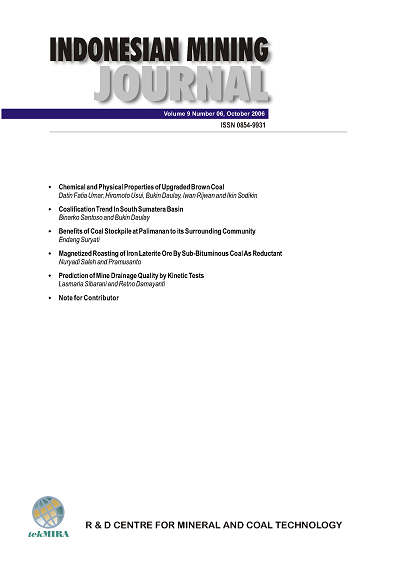
INDONESIAN MINING JOURNAL Vol. 09 No. 3 October 2006
Vol. 9 No. 3 (2006)Current edition of the journal is focused on coal, mineral and mining environment. Coal issues are still getting special portion. It is understandable, because Indonesia is endowed with abundant coal deposits that presumably are admissible energy consumption for 150 years ahead. A lot of aspects of the sources are significant to be studied in terms of solving problems as the real steps to support the development of coal-based energy sources in Indonesia. From now, Indonesia is at- tempting to strive for substituting fuel oil-based energy into coal-based energy. Chemical and physi- cal properties of Indonesian coals are appropriate in the upgraded brown coal (UBC) process, particularly in reducing moisture content and calorific value. In accordance with coal rank, simi- larities and differences in rank characteristics of the Bukit Asam coals indicate their geological setting, particularly influence of the andesitic intrusions. The higher rank of the coals is a result of higher regional coalification level in the basin. Coal stockpile in Palimanan is beneficial to sur- rounding communities due to increase of income and multiplier effect. However, its negative im- pact is present due to dust pollution from the stockpile and the transportation.
A paper related to developing mineral commodity from aspects of potential, processing technology and engineering is served in this issue. It discusses iron laterite ore. Limonite in laterite iron ore can be transformed into ferromagnetic product by using coal as reductant in rotary kiln. Then, the roasted product are concentrated using low magnetic intensity.
The last paper focuses on mine drainage issues. Acid mine drainage (AMD) is significant and expensive environmental concern in mining industry. It must be predicted prior to starting mining operation. A model of kinetic test is required to calibrate and validate the quality of AMD.
It is realised that all the above aspects are not totally discussed yet in this edition. However, it is expected that some of those papers could be a golden bridge to cope with the gap faced by those commodities in Indonesia, particularly between the industrial sectors and R&D institutions.
The Editor
-
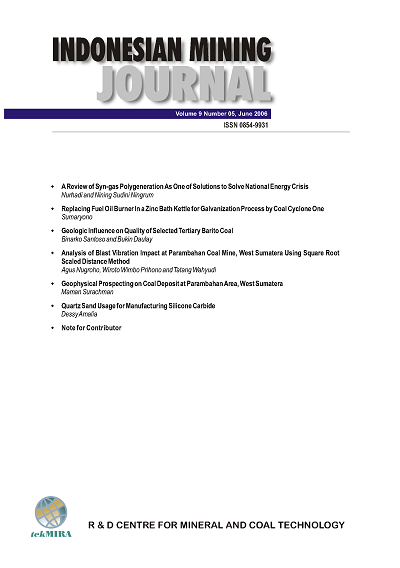
INDONESIAN MINING JOURNAL Vol. 09 No. 2 June 2006
Vol. 9 No. 2 (2006)Coal is still getting particular portion in this Indonesian Mining Journal edition. Many aspects of the sources are necessary to be studied in terms of solving problems as the real steps to support the development of coal-based energy sources in Indonesia. Even more, Indonesia is endowed with abundant coal deposits that presumably are admissible energy consumption for 150 years a head. Accordingly, from now Indonesia is attempting to strive for substituting fuel oil-based energy into coal-based energy. An anthology of research results that is coming forward in this journal would discuss in line with the above issues.
In terms of current global issues of developing clean coal technology, a paper reviews syn-gas polygeneration technology system from integrated coal gasification. Synthetic gas and other vari- ous gas derivation products might be produced from the system. The products are applicable as either fuel or raw material for chemical industries. Ishikawajima-Harima Heavy Industries Co, who conducts the system, claims the syn-gas polygeneration technology system economically effi- cient in consuming coal raw materials and environmentally safe. Other paper discusses an experi- mental study on utilizing coal to alternate fuel oil burner with coal cyclone burner specifically in a heating zinc bath kettle of galvanization process. The energy efficiency of utilizing coal is found lower than fuel oil. One more paper discusses the utilization of coke. Coke, which was previously made from coal, is reacted with high-grade quartz sand in an electric-arc furnace producing silicon carbide as a refractory ceramic material. Essentially, three papers issued in the present journal discuss the development of coal utilization.
Coal geology and mining are also presented in this journal. One paper analyzes type and rank variation of the Tertiary coals formation using petrographic examination, where was found that similarities and differences of type and rank of the coals reflect their geological setting. A study on type and thickness of such rock as overburden on the coal seam by using geophysical prospecting method was realized a reasonable mining activity, whether the coal seam could be mined by open pit method or by underground method. At the end of the present journal, however, a paper come out with an analysis of vibration due to blasting activities in coal mines and its influences surroun- ding areas and safety.
The Editor.
-
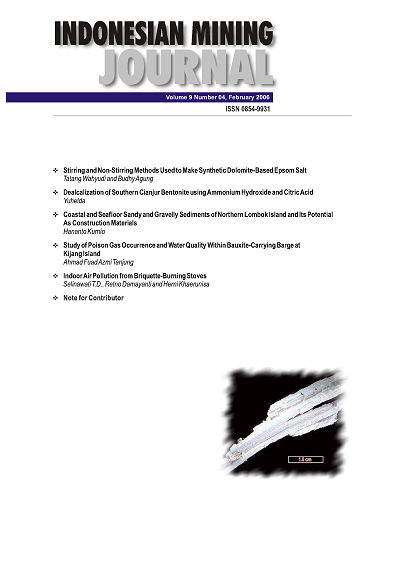
INDONESIAN MINING JOURNAL Vol. 09 No. 1 February 2006
Vol. 9 No. 1 (2006)The unique geological setting of Indonesia has made Indonesia as one of the richest countries in the world for natural and mineral resources. However, mastering in mineral processing technology is still one of problems when beneficiating the minerals, notably to benefit those that do not fulfill industrial specification or have limited deposits. Indonesia retains some industrial mineral deposits that are limited in reserve or need upgrading prior to marketing them. Seeking a new processing technology seems the answer to solve the problems. Three papers issued in this journal discuss about mineral upgrading and potential.
The fatal gas blast occurred in Daping coal mine, Henan Province – China in 2004, has left 79 dead and 69 others missing with slim chance of survival by Saturday afternoon, while another 57 people were reported killed or missing in three other coals mine accidents. Similar to Daping tragedy, an accident took place at Kijang Island, Indonesia implies that mine safety is crucial to obtain convenient work environment. A study regarding Kijang Island tragedy had been conducted and its result is presented in this issue.
Negative impact related to mine activities produces adverse environmental changes due to mine pollutant occurrence and landscape change. Contaminants come from mining industries affect the biological, recreational, industrial, and municipal use of larger rivers many miles downstream from mining. Water becomes contaminated when it comes in contact with solid mining waste that remains after mining has ceased and so does the air. It will be polluted by dust, gas or smoke from mining industries. A good environmental management is required to have clean environment. Gas emissions from briquette burning that might be pollutant source need to be studied. A paper re- garding such an effort is discussed in this journal.
Have a good time to read them. Best regards to all. The Editor.
-

INDONESIAN MINING JOURNAL Vol. 8 No. 1 February 2005
Vol. 8 No. 01 (2005)Our coverage this issue is focused on methane gas, coal, and mineral. The main issues in developing those commodities are to supply them in industries sector that is big enough, but most of them are imported due to their quality and specification are not fulfilled yet in our country.
Moreover, potentials of the commodities are not utilised optimally yet, non-conducive regulation for investment, export of raw materials, processing technology and engineering capabilities and no accurate data and information. These issues cause setbacks of the mining sector in obtaining the foreign exchange. This reality is an indication the presence of gap between the potential and the
technology (including the human resources); industry and research and development institutions and so forth. For this reason, this current edition is offering contributions to cope with those issues.
This current edition is trying to provide opportunities in developing the commodities from aspects of potential and processing technology and engineering. Several papers of potential aspect discuss the occurrence of methane gas seepages in Ketungau-West Kalimantan by Hermes
Panggabean; and the quality of the Ombilin coals based on their petrographic analysis by Binarko Santoso and Bukin Daulay. Issues on the processing technology and engineering include the upgrade of the Indonesian low rank coals by Datin Fatia Umar et al., the optimalisation of lubricant waste recycling with low rank coals by Nining Sudini Ningrum and Ika Monika; and finally synthesis of
Na-A zeolite by Sariman.
Although all the aspects are not discussed yet in this edition, we expect that some of the papers could be a golden bridge to cope with the gap faced by those commodities in this country, particularly between the industrial sectors and the research and development institution. Have a good time to read them.
